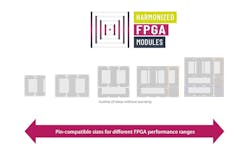Pioneering FPGA-on-Modules: SGET Works to Develop Standard
What you’ll learn:
- Why board-level standardization of FPGA implementations matter.
- What the Harmonized FPGA Module (HFM) standard entails.
- How semiconductor manufacturers, embedded module manufacturers, VARs, system integrators, and OEMs can benefit from the new standard for FPGA-on-modules.
Small-form-factor (SFF) standards like the Open Module Standard (OSM) are just one of many computer-on-module (COM) standards fostered by SGET. I had a chance to talk with Ansgar Hein, Chair of the Standardization Group for Embedded Technologies (SGET), about the organization and work on the latest standard, the Harmonized FPGA Module (HFM). HFM is a work in progress, but it offers some compelling features to developers.
Wong: What is the SGET?
Hein: As an international not-for-profit association, we collaboratively promote the advancement of science, technology, and research, specifically in the field of embedded computing. Since our founding in 2012, the SGET has grown to more than 70 members. These include embedded-computing companies, board- and system-level manufacturers, semiconductor and connector manufacturers, software developers, and research organizations.
Today, we are well known for developing global embedded-computing specifications, particularly for small-form-factor modules, such as the SMARC, OSM, and Qseven standards.
We recently recognized the growing importance of the U.S. market in the embedded-systems design industry, particularly in the adoption of OSM modules—the first standard for SMT-capable computer-on-modules as well as in module technology for FPGAs.
Can you briefly explain the significance of FPGA technology in today's board-level products and OEM applications?
FPGAs have become a cornerstone of modern board-level products and OEM applications due to their unparalleled flexibility, performance, and efficiency. They’re widely used in various industries, including telecommunications, automotive, aerospace, defense, and medical.
Demand for FPGAs is driven by their ability to handle complex data-processing tasks with high efficiency, enabling real-time data throughput while minimizing latency and thermal design power (TDP). This makes them ideal for applications such as artificial intelligence (AI), Internet of Things (IoT), 5G/6G infrastructures, and advanced driver-assistance systems (ADAS), where high performance and adaptability are crucial. As a result, the FPGA market is expected to grow by approximately 16.4% annually.1
But the importance of FPGA technology in today's OEM applications goes beyond performance. FPGAs offer a unique advantage in that they can be reconfigured even after deployment, unlike application-specific integrated circuits (ASICs), which have fixed circuits after manufacture. This reconfigurability enables continuous optimization of electronic circuit designs to meet evolving application requirements.
Why do FPGAs need standardization on the module level?
FPGAs are key to applications ranging from image and video stream analysis to big data processing and audio digitization. However, these diverse applications often require FPGAs designed for specific logical circuits and interfaces.
The same is true for FPGA-based SoCs, which are a primary focus of SGET’s standardization efforts. By standardizing the form factor and interfaces of FPGA implementations on the module level, OEM can scale their design across different FPGA processor families and vendors such as AMD, Intel, Microsemi, and others (see table). A single carrier board design can accommodate FPGA-based SoCs from multiple vendors without the need for extensive modification, thereby simplifying the design process and reducing costs.
The new SGET module standard aims to make FPGAs scalable across families and manufacturers (table lists the 10 largest manufacturers today).2
Standardization has already proven its benefits in the embedded x86 and Arm processor markets, and now these benefits are being extended to FPGAs and FPGA-based SoCs. Developers will have access to application-ready FPGA cores with standardized interfaces, fully validated packages, and comprehensive software support.
This "plug & boot" approach significantly reduces time-to-market and non-recurring engineering (NRE) costs compared to custom FPGA integrations. Additionally, standardized FPGA modules offer benefits like second sourcing, scalability across generations and architectures, and potentially even ASIC integration.
All of this ensures long-term availability and provides OEMs with high design security and maximum return on investment, while also lowering circuit board costs by distributing high current density more efficiently across the carrier board.
What does the new Harmonized FPGA Module (HFM) standard cover?
The HFM initiative aims to not only harmonize drivers, interfaces, pinouts, and form factors across all FPGA manufacturers, but also the two mounting options for the FPGA modules, each of which offers its own advantages. It specifies both soldered and pluggable modules to cater to a wide range of applications, from high-speed interfaces requiring robust integration to larger FPGA-based SoCs that benefit from easy evaluation and prototyping (see figure).
This approach simplifies the design process and ensures long-term availability and scalability, providing significant benefits to OEMs. At present, we’re close to the first draft of the new standard, which focuses on solderable Harmonized FPGA Modules (s.HFM). The Standard Development Team is very dedicated to bringing this new standard to the market within a short time.
How exactly does the industry benefit from the standardization?
The new HFM standard enables FPGA solution providers, who previously offered dedicated proprietary PCB designs, to broaden their market reach with a standardized product portfolio while maintaining their design expertise. They can continue to offer full custom designs for large volumes and now also cater to medium industrial batch sizes with FPGA modules. This ensures sustainable revenue through consistent demand over the entire lifecycle of customer applications.
Additionally, standardized modules benefit FPGA manufacturers by allowing them to enter the industrial batch size market and delegate support to module manufacturers. This expanded ecosystem around FPGA technologies, facilitated by standardization, creates a win-win scenario for semiconductor and module manufacturers, as well as OEMs who use FPGA modules in their solutions. Plus, of course, for customers who are looking for FGPA solutions and the benefit of open standards in combination with second source and all of the benefits already mentioned.
You’re highlighting the technology at a number of shows and conferences, including last year's Embedded World. What can attendees expect to learn at these events?
Attendees can anticipate informative sessions and exhibits. At the events, we will provide detailed information on the benefits and implementation of the HFM standard, including how it streamlines the integration of FPGAs and FPGA-based SoCs across various applications. Attendees will have the opportunity to see demonstrations of standardized FPGA modules and meet with leading manufacturers and technology experts.
Moreover, the event will highlight the collaborative efforts of organizations like ours in driving these advances. For example, this year’s conference will feature a joint special SGET and PICMG track on open standards in the embedded space and how best to implement and use them.
In general, we encourage manufacturers and users to get involved and participate in the standardization process. This is a unique opportunity to influence the development of critical industry standards and ensure that your specific requirements are considered.
References
1. https://www.marketsandmarkets.com/Market-Reports/fpga-market-194123367.html.
2. https://www.linkedin.com/pulse/top-10-fpga-manufacturers-world-ebics-fpga/ Source: © Ebics FPGA, Distributor for FPGAs.
About the Author
William G. Wong
Senior Content Director - Electronic Design and Microwaves & RF
I am Editor of Electronic Design focusing on embedded, software, and systems. As Senior Content Director, I also manage Microwaves & RF and I work with a great team of editors to provide engineers, programmers, developers and technical managers with interesting and useful articles and videos on a regular basis. Check out our free newsletters to see the latest content.
You can send press releases for new products for possible coverage on the website. I am also interested in receiving contributed articles for publishing on our website. Use our template and send to me along with a signed release form.
Check out my blog, AltEmbedded on Electronic Design, as well as his latest articles on this site that are listed below.
You can visit my social media via these links:
- AltEmbedded on Electronic Design
- Bill Wong on Facebook
- @AltEmbedded on Twitter
- Bill Wong on LinkedIn
I earned a Bachelor of Electrical Engineering at the Georgia Institute of Technology and a Masters in Computer Science from Rutgers University. I still do a bit of programming using everything from C and C++ to Rust and Ada/SPARK. I do a bit of PHP programming for Drupal websites. I have posted a few Drupal modules.
I still get a hand on software and electronic hardware. Some of this can be found on our Kit Close-Up video series. You can also see me on many of our TechXchange Talk videos. I am interested in a range of projects from robotics to artificial intelligence.



